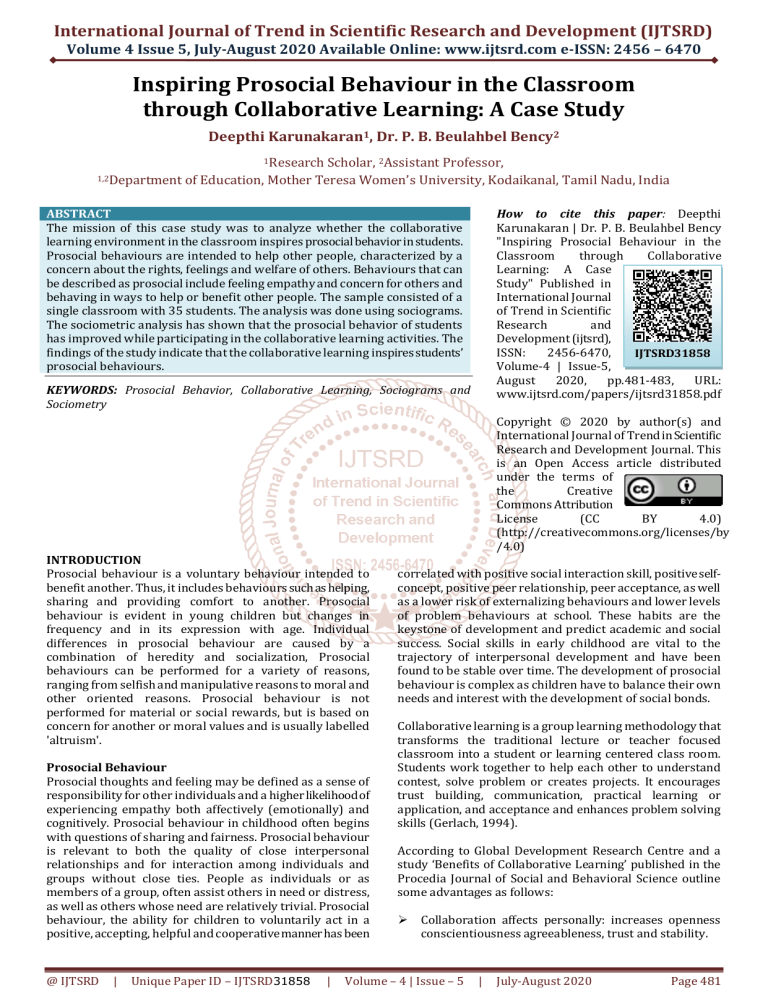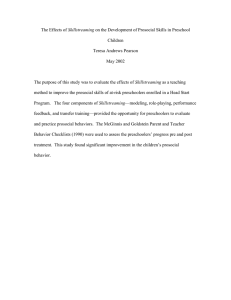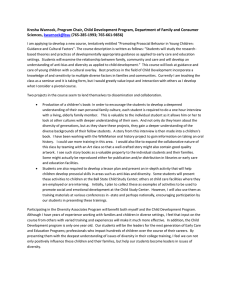
International Journal of Trend in Scientific Research and Development (IJTSRD)
Volume 4 Issue 5, July-August 2020 Available Online: www.ijtsrd.com e-ISSN: 2456 – 6470
Inspiring Prosocial Behaviour in the Classroom
through Collaborative Learning: A Case Study
Deepthi Karunakaran1, Dr. P. B. Beulahbel Bency2
1Research
Scholar, 2Assistant Professor,
1,2Department of Education, Mother Teresa Women’s University, Kodaikanal, Tamil Nadu, India
ABSTRACT
The mission of this case study was to analyze whether the collaborative
learning environment in the classroom inspires prosocial behavior in students.
Prosocial behaviours are intended to help other people, characterized by a
concern about the rights, feelings and welfare of others. Behaviours that can
be described as prosocial include feeling empathy and concern for others and
behaving in ways to help or benefit other people. The sample consisted of a
single classroom with 35 students. The analysis was done using sociograms.
The sociometric analysis has shown that the prosocial behavior of students
has improved while participating in the collaborative learning activities. The
findings of the study indicate that the collaborative learning inspires students’
prosocial behaviours.
How to cite this paper: Deepthi
Karunakaran | Dr. P. B. Beulahbel Bency
"Inspiring Prosocial Behaviour in the
Classroom
through
Collaborative
Learning: A Case
Study" Published in
International Journal
of Trend in Scientific
Research
and
Development (ijtsrd),
ISSN:
2456-6470,
IJTSRD31858
Volume-4 | Issue-5,
August
2020,
pp.481-483,
URL:
www.ijtsrd.com/papers/ijtsrd31858.pdf
KEYWORDS: Prosocial Behavior, Collaborative Learning, Sociograms and
Sociometry
INTRODUCTION
Prosocial behaviour is a voluntary behaviour intended to
benefit another. Thus, it includes behaviours such as helping,
sharing and providing comfort to another. Prosocial
behaviour is evident in young children but changes in
frequency and in its expression with age. Individual
differences in prosocial behaviour are caused by a
combination of heredity and socialization, Prosocial
behaviours can be performed for a variety of reasons,
ranging from selfish and manipulative reasons to moral and
other oriented reasons. Prosocial behaviour is not
performed for material or social rewards, but is based on
concern for another or moral values and is usually labelled
'altruism'.
Prosocial Behaviour
Prosocial thoughts and feeling may be defined as a sense of
responsibility for other individuals and a higher likelihood of
experiencing empathy both affectively (emotionally) and
cognitively. Prosocial behaviour in childhood often begins
with questions of sharing and fairness. Prosocial behaviour
is relevant to both the quality of close interpersonal
relationships and for interaction among individuals and
groups without close ties. People as individuals or as
members of a group, often assist others in need or distress,
as well as others whose need are relatively trivial. Prosocial
behaviour, the ability for children to voluntarily act in a
positive, accepting, helpful and cooperative manner has been
@ IJTSRD
|
Unique Paper ID – IJTSRD31858
|
Copyright © 2020 by author(s) and
International Journal of Trend in Scientific
Research and Development Journal. This
is an Open Access article distributed
under the terms of
the
Creative
Commons Attribution
License
(CC
BY
4.0)
(http://creativecommons.org/licenses/by
/4.0)
correlated with positive social interaction skill, positive selfconcept, positive peer relationship, peer acceptance, as well
as a lower risk of externalizing behaviours and lower levels
of problem behaviours at school. These habits are the
keystone of development and predict academic and social
success. Social skills in early childhood are vital to the
trajectory of interpersonal development and have been
found to be stable over time. The development of prosocial
behaviour is complex as children have to balance their own
needs and interest with the development of social bonds.
Collaborative learning is a group learning methodology that
transforms the traditional lecture or teacher focused
classroom into a student or learning centered class room.
Students work together to help each other to understand
contest, solve problem or creates projects. It encourages
trust building, communication, practical learning or
application, and acceptance and enhances problem solving
skills (Gerlach, 1994).
According to Global Development Research Centre and a
study ‘Benefits of Collaborative Learning’ published in the
Procedia Journal of Social and Behavioral Science outline
some advantages as follows:
Collaboration affects personally: increases openness
conscientiousness agreeableness, trust and stability.
Volume – 4 | Issue – 5
|
July-August 2020
Page 481
International Journal of Trend in Scientific Research and Development (IJTSRD) @ www.ijtsrd.com eISSN: 2456-6470
Team work strengthens community bonds, socialization
and both written and verbal communication.
Collaboration increases measures of achievement.
Group work increases subject matter comprehension
efficiency and productivity.
Group work increases self-esteem.
Collaborative leaning increases student retention.
Behaviours that can be described as prosocial include feeling
empathy and concern for others and behaving in ways to
help or benefit other people (Jhang & Liu, 2016). The mission
of this case study was to analyse whether the collaborative
learning inspires pro social behaviour in the classroom.
Need and Significance of the Study
Schools can foster the prosocial behaviours in students, since
a school represents a miniature society. Students in a school
are actually trained for their life in the real society. They
learn the necessary prosocial behaviour such as helping and
sharing though the different occasions while they are in the
school. Even though there is a heredity basis of this
behaviour, it is moulded and polished in a school
environment where the child is spending its most of the
time.
Educational researches have shown that collaborative
classroom leads students to an exposure to and an increase
in understanding of diverse perspective and prepares the
students for real life social situations. The present school
curriculum insists upon activity-oriented instruction. The
investigator utilized collaborative learning method for
ensuring the maximum participation of students in her
classroom. In different classroom situations it could be seen
that students show a tendency to help others while
completing a project or an assignment or any other
demonstration. This led the investigator to conduct a case
study to find whether the collaborative learning methods
inspire prosocial behaviour in students. Since the
development of prosocial behaviour is a necessity in an era
where antisocial behaviour of human beings is increasing at
an alarming rate where man is fighting with his fellow beings
for even the basic necessities the present study is a need of
the hour and is significant.
Statement of the Problem
Thus, the present study is entitled as ‘Inspiring Prosocial
Behaviour in the Classroom through Collaborative Learning:
A Case Study’.
Objectives of the Study
1. To analyse the prosocial interaction pattern of
secondary school students.
2. To identify the lacking of prosocial behaviour in
individuals.
3. To assess whether the collaborative learning methods
inspires the prosocial behaviour in students.
Research Questions
The present case study is a result of some research questions
such as:
1. Do all children show prosocial behaviour?
2. How to find the students, who lack prosocial behaviour,
at the same time who are not anti-socials?
3. Do collaborative learning methods inspire prosocial
behaviour in school students?
@ IJTSRD
|
Unique Paper ID – IJTSRD31858
|
Method of the Study
The investigator used case study method for the present
study. This case study method is qualitative in nature.
Population and Sampling
Population means the total individuals occupying an area or
making up a whole. A sample is the small portion of the
population that is selected for observation and analysis. In
this study the population is the secondary school students of
Girls Vocational Higher Secondary School at Pirappancode in
Thiruvananthapuram District, Kerala and the sample are an
individual classroom with 35 students from this population.
Tools Used
The following tools were utilized by the investigator for the
present study:
Observation
Sociogram
Methodology
In the present study, the investigator has utilized case study
method according to the nature of the study.
Case studies are in-depth investigation of a single person,
group, event or community. Data are gathered from a variety
of sources and by using several different methods such as
observations, interviews, etc. But in the present study
investigator has utilized observation as well as sociometry as
the source of data. Since the investigator’s research is based
on collaborative learning, she utilized various collaborative
learning methods such as Jigsaw method, Think Pair Share
method, Concept Mapping method, 5E method and Activity
method in her classroom. During these classes, investigator
observed that students in her classroom show cooperation,
helping mentality, empathy etc. This led to the present study
since the investigator wanted to check whether these
behaviours are inspired by the collaborative learning.
The investigator has utilized sociometry for the data
collection. At first the investigator provided her class a set of
three situations and asked her students to select three of
their peers whom they would approach in a situation of
need. The situations given were from the real life. By using
the set of peers selected by each student in her class,
investigator created three sociograms.
Again, the investigator has provided collaborative learning
strategies for further classes for a duration of one month.
The investigator again checked the prosocial behaviour
using a new set of real-life situations and based on the
selection of each student’s peers she prepared another set of
sociograms.
Both the set of sociograms were analysed and interpreted.
Analysis and Interpretation
Analysis of a qualitative data means studying the organised
material in order to discover its inherent facts. The data are
studied from as many angles as possible either to explore the
new facts or to reinterpret already existing facts. The content
analysis and logical analysis are mostly used in analysis of
qualitative material. Analysis is among the first of the
method which a researcher will call upon in his way to
reduce a field size to a manageable data from a change of
information.
Volume – 4 | Issue – 5
|
July-August 2020
Page 482
International Journal of Trend in Scientific Research and Development (IJTSRD) @ www.ijtsrd.com eISSN: 2456-6470
Analysis of data is the heart of the research report. The mass
of collected data through the administration of the tools
need to be analysed and interpreted to know what the
results show, what they mean, what is the significance and
what is the answer of the original problems. It may be
considered as the wheels of the search machinery without
which data and other material have no specific function to
perform. It involves breaking down of existing complex
factors in to simple parts and putting these parts together in
a new arrangement for the purposes of data which means
the study of tabulated materials in order to determine facts
of meanings. Thus, analysis gives shapes and form to the
study.
Investigator analysed both the sociograms prepared within
duration of one month. Analysis of the first set of sociogram
has revealed that there were three isolates and no stars and
many mutual in the first sociogram. It is interpreted that
three students were not at all selected by any one of their
classmates in the given situations and there were none of the
students who were selected by most of the peers in a
situation of need.
In the second set of sociogram, the analysis has shown that
the number of isolates was reduced to none and the number
of stars was increased to one. Thus, it is interpreted that
after regularly participating in collaborative classroom,
students were started communicating and interacting with
their peers in the classroom and as a result the number of
isolates were reduced to none. The result comparison shows
that collaborative classroom inspires prosocial behaviour in
students.
Conclusion
The investigator conducted a case study entitled as ‘Inspiring
prosocial behaviours in students through collaborative
@ IJTSRD
|
Unique Paper ID – IJTSRD31858
|
learning: A case study’. The investigator adopted case study
method for this study. For data collection, the investigator
used some tools such as sociogram and observation. The
investigator has utilized qualitative data analysis. The
analysis showed that through collaborative learning in the
classroom which encourages students’ interdependence,
responsibility and communication, prosocial behaviours are
inspired among the school students.
References
[1] Barkely, E. F., Cross, K. P. & Howell Major, C. (2005).
Collaborative Learning Technique: A Hand Book for
College Faculty. San Francisco: Jossey - Boss.
[2] Gerlach, J. M., (1994). “Is this Collaboration?” In
Bosworth, K. and Hamilton, S.J. (Eds.), Collaborative
Learning: Underlying Processes and Effective
Technique, New Directors for Teaching and Learning
No. 59.
[3] Smith, B. L., Mac Gregor, J. T. (1992). “What is
Collaborative Learning?” In Goodsell, A. S., Maher, M. R.,
and Tinto, V. (Eds.), Collaborative Learning: A Source
book for Higher Education. National Centre on
Postsecondary Teaching, Learning & Assessment,
Syracuse University.
[4] Vygotsky, L. S, (1978). “Mind in Society” Cambridge:
Harward University Press.
[5] Case Study: Inspiring Prosocial Behavior in Workplace.
Retrieved from https://seatedmassage.com.au on 18/
04/2020.
[6] Jahng, K. E. & Liu, K., (2016). Elementary School
Students’ Experiences in South Korea: A Case Study.
Retrieved from https:// researchgate.net on
18/04/2020.
Volume – 4 | Issue – 5
|
July-August 2020
Page 483





